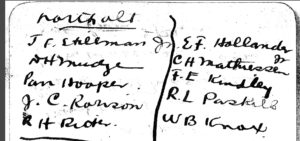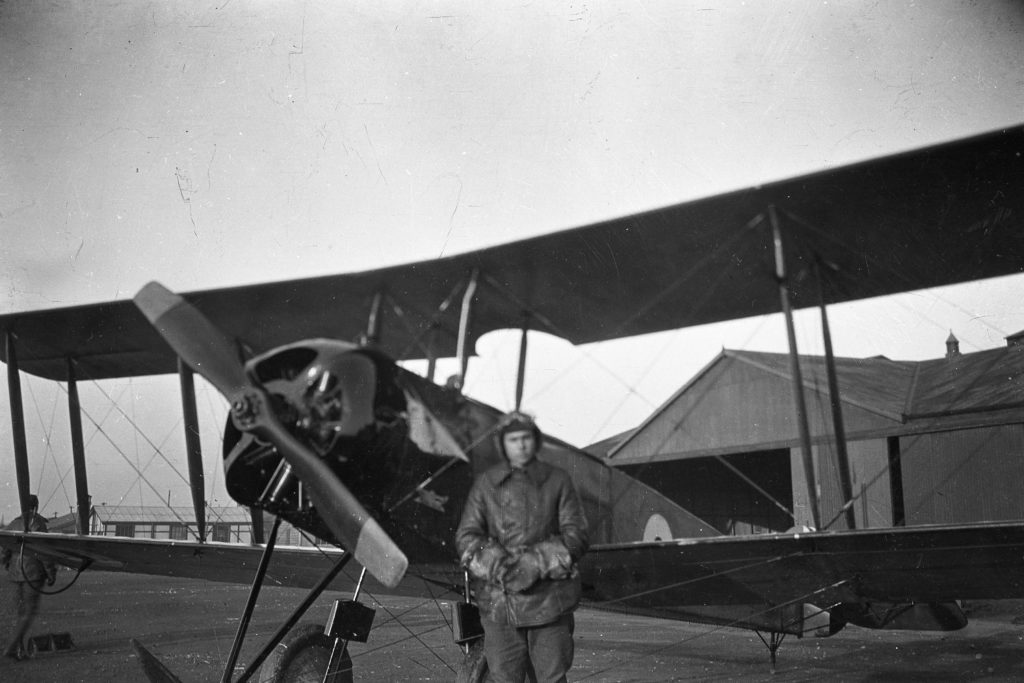(Philadelphia, Pennsylvania, October 3, 1897 – Upper Darby, Pennsylvania, April 20, 1962).1
Hollander’s paternal grandparents emigrated from Germany, his maternal grandparents from England. His Boston-born father, Henry Morris Hollander, was working for a department store in Philadelphia when Edward Frank was born. By 1905, the family had moved to Brooklyn, where Mr. Hollander was a department store manager; his work then took the family back to Massachusetts. In 1917, they were living in Providence, Rhode Island.2
Edward Frank Hollander was at the Officers’ Training Camp at Plattsburg, New York, in July 1917 when twenty-five of the men, including himself, were selected to go to M.I.T. for aviation training 3 He graduated from ground school at M.I.T. with the class of August 25, 1917.4 There is a photo of this class that belonged to Joseph Raymond Payden, who collected signatures of his classmates on the back. Hollander appears to have written “Chicago ’15″ after his name, but I have not thus far been able to find a record of college attendance.5
Along with about one third of his ground school classmates, Hollander chose or was chosen for flight training in Italy and was thus one of the 150 men of the “Italian” or “second Oxford detachment” who sailed to England on the Carmania. They departed New York for Halifax on September 18, 1917, and departed Halifax as part of a convoy for the Atlantic crossing on September 21, 1917. When the Carmania docked at Liverpool on October 2, 1917, the detachment learned to their initial consternation that they were not to go to Italy but to remain in England and repeat ground school at the Royal Flying Corps’s No. 2 School of Military Aeronautics at Oxford University. Various explanations have been offered for the snafu, to use an acronym from the next war.6 Whatever the reason, the detachment fairly quickly made their peace with the change and in retrospect recognized the benefit of R.F.C. training.
On November 3, 1917, Hollander and all but twenty of the detachment members left Oxford for Harrowby Camp, a machine gun training center near Grantham in Lincolnshire. There they spent about two weeks in classes and on the range learning to fire Lewis machine guns, with the prospect of another two learning about the Vickers machine gun.

The would-be pilots were in a holding pattern because there were not yet openings at training squadrons to accommodate them. However, about halfway through November the men learned that places for fifty of them had been found, and Hollander was among those fifty.7

On November 19, 1917, he and nine others (Joseph Frederick Stillman, Jr., Dudley Hersey Mudge, Parr Hooper, John Chadbourn Rorison, Roland Hammond Ritter, Conrad Henry Matthiessen, Jr., Field Eugene Kindley, Reuben Lee Paskill, and Walter Burnside Knox) set out for Northolt, on the northwest outskirts of London.8 Once arrived, Parr Hooper, also assigned to Northolt, reported that “Everybody here are officers except the mechanics. There are about 150 men training, 2 elementary squadrons and one advanced. We 10 Americans (5 in the 2nd squadron and 5 in the 4th squadron) are ranked as cadets but are treated as officers.”9 Hollander’s very sketchy R.A.F. service record does not indicate whether he was in No. 2 or No. 4 Training Squadron, but information about Field Eugene Kindley’s time at No. 4 and Hooper’s at No. 2 suggest that the training was practically identical.10 The plane flown was the ubiquitous Maurice Farman S. 11 Shorthorn or “Rumpty,” and when there was “good calm weather flying goes on all day from sunrise to sunset with time out for the instructor to eat and have tea.” In the frequent bad weather, the men put in time at “at wireless, machine gun, bombs, Art. Obs. [artillery observation] classes.”11 Around the first week of December, the men had enough hours to start flying solo: Conrad Henry Matthiessen soloed on December 3, Hooper on December 4, and Kindley, after some bumpy dual flying, on December 8, 1917.12 Hollander’s course was presumably similar.
On December 18, 1917, Kindley, Hooper, and some of the other men at Northolt, probably including Hollander, were reassigned. Hooper went to nearby London Colney; he took a photo of Hollander standing by an Avro there in early January 1918.

There is also a photo of Hollander in front of a Spad VII, and it is possible that this was the same plane that served as a backdrop for photos of Hooper, Thomas John Herbert, and Robert Alexander Anderson at London Colney.13 Hooper was at No. 56 Training Squadron; others were across the field at No. 74, but, as at Northolt, the instruction was similar at the two training squadrons. The men began on Avros, initially dual and then solo, before moving on to Spads and Sopwith Pups.14
By mid-March 1918, Hollander had completed enough flying to be recommended for a commission; the cable confirming his appointment is dated April 6, 1918.15 He was at Turnberry on April 15, 1918, when he was placed on active duty, and still there or at Ayr on May 21, 1918, when he and his fellow second Oxford detachment members Paskill and Alexander Miguel Roberts were among the pall bearers at the funeral of George Clarke Squires at Doune Cemetery in Girvan.15a
I find no further documentation on Hollander until September 6, 1918, when Hollander married Helene McGregor Lochhead of Ayr.16 Whether because of his married status or for other reasons, Hollander was apparently not assigned to an operational squadron. A notation on his R.A.F. service record has him at “1 Stores Depot” in October and November of 1918.17

Hollander and his wife returned to the U.S. on the U.S.S. Plattsburg in August 1919.18 They settled in Rhode Island, and he was employed as a salesman for a tool company.19
mrsmcq March 8, 2018
Notes
(For complete bibliographic entries, please consult the list of works and web pages cited.)
1 For Hollander’s place and date of birth, see Ancestry.com, U.S. WWII Draft Cards Young Men, 1940-1947, record for Edward Frank Hollander. For his place and date of death, see Ancestry.com, Pennsylvania, Death Certificates, 1906–1963, record for Edward Frank Hollander.
2 Information about the Hollander family is based on documents available at Ancestry.com.
3 “Twenty-five Plattsburg Men to Become Aviators.”
4 “Ground School Graduations [for August 25, 1917].”
5 Payden and Payden, compilers, J.R.: Joseph R. Payden, 1915–1925, p. 19.
6 See, for example, the explanations supplied by Hamilton Hadley on p. 4 (286) of “Foreign Aviation Detachments,” by Geoffrey Dwyer on p. 2 of “Report on Air Service Flying Training Department in England,” and by Claude E. Duncan as recorded in Sloan and Hocutt, “The Real Italian Detachment,” p. 44.
7 Hooper, Somewhere in France, letter of November 14, 1917.
8 See Foss, diary entry for November 15, 1917, which lists the men leaving along with their assignments. See Hooper, Somewhere in France, letter of November 23, 1917, regarding their departure.
9 Hooper, Somewhere in France, letter of November 23, 1917.
10 On Kindley, see Ballard, War Bird Ace, pp. 23–24. On Hooper, see Hooper, Somewhere in France, Chapter 4.
11 Hooper, Somewhere in France, letter of November 23, 1917.
12 On Matthiessen and Hooper, see Hooper, Somewhere in France, letter of December 4, 1917; on Kindley, see Ballard, War Bird Ace, p. 24.
13 The photo of Hollander is reproduced on p. 17 of Miller, “Jesse Orrin Creech.” The photo of Anderson is reproduced on p. 11 of Stone, From a Joyful Heart (where the plane is misidentified as an S.E.5), and on p. 158 of Mallahan, “Shot with Luck!” For the photo of Herbert, see here. The photo of Hooper is among the photos appended to Chapter 7 of Hooper, Somewhere in France.
14 Information on training at London Colney is based in part on the Pilot’s Flying Log Books of Hooper and Marvin Kent Curtis.
15 See cablegrams 739-S (March 16, 1918) and 1049-R.
15a See Biddle, “Special Orders No. 35” and Rees, Letter to Mrs. George C. Squires.
16 See Ancestry.com, U.S. Passport Applications, 1795–1925, record for Helene M Hollander.
17 See National Archives (United Kingdom), Royal Air Force officers’ service records 1918–1919, record for Edward Frank Hollander.
18 For Hollander’s passage home, see War Department, Office of the Quartermaster General, Army Transport Service, Lists of Incoming Passengers, 1917 – 1938, Passenger list of casual officers for U.S. (married) on U.S.S. Plattsburg. For his wife, see Ancestry.com, New York, Passenger Lists, 1820–1957, record for Helene M Hollander.
19 See Ancestry.com, 1920 United States Federal Census, record for Edward F Hollander.
